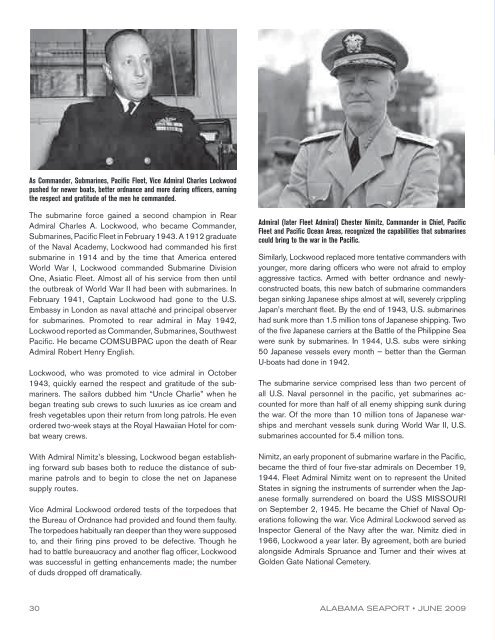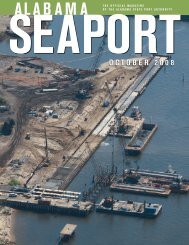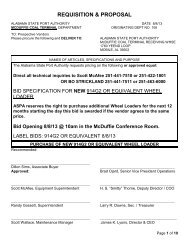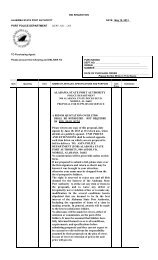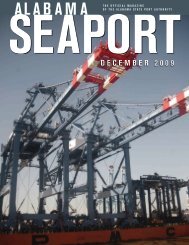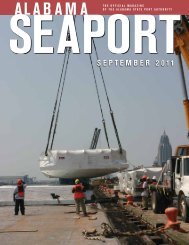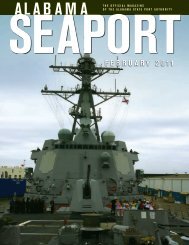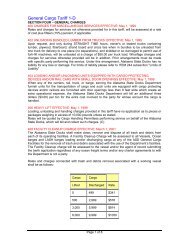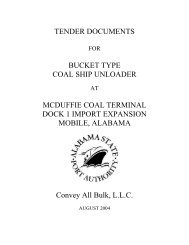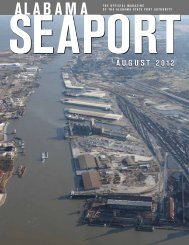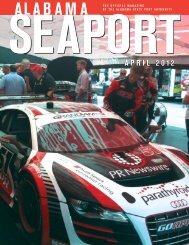June 2009 - Alabama State Port Authority
June 2009 - Alabama State Port Authority
June 2009 - Alabama State Port Authority
You also want an ePaper? Increase the reach of your titles
YUMPU automatically turns print PDFs into web optimized ePapers that Google loves.
established 1892<br />
global logistics<br />
progress anchored in tradition<br />
supply chain management • general & bulk cargo • automotive specialists<br />
As Commander, Submarines, Pacific Fleet, Vice Admiral Charles Lockwood<br />
pushed for newer boats, better ordnance and more daring officers, earning<br />
the respect and gratitude of the men he commanded.<br />
The submarine force gained a second champion in Rear<br />
Admiral Charles A. Lockwood, who became Commander,<br />
Submarines, Pacific Fleet in February 1943. A 1912 graduate<br />
of the Naval Academy, Lockwood had commanded his first<br />
submarine in 1914 and by the time that America entered<br />
World War I, Lockwood commanded Submarine Division<br />
One, Asiatic Fleet. Almost all of his service from then until<br />
the outbreak of World War II had been with submarines. In<br />
February 1941, Captain Lockwood had gone to the U.S.<br />
Embassy in London as naval attaché and principal observer<br />
for submarines. Promoted to rear admiral in May 1942,<br />
Lockwood reported as Commander, Submarines, Southwest<br />
Pacific. He became COMSUBPAC upon the death of Rear<br />
Admiral Robert Henry English.<br />
Lockwood, who was promoted to vice admiral in October<br />
1943, quickly earned the respect and gratitude of the submariners.<br />
The sailors dubbed him “Uncle Charlie” when he<br />
began treating sub crews to such luxuries as ice cream and<br />
fresh vegetables upon their return from long patrols. He even<br />
ordered two-week stays at the Royal Hawaiian Hotel for combat<br />
weary crews.<br />
With Admiral Nimitz’s blessing, Lockwood began establishing<br />
forward sub bases both to reduce the distance of submarine<br />
patrols and to begin to close the net on Japanese<br />
supply routes.<br />
Vice Admiral Lockwood ordered tests of the torpedoes that<br />
the Bureau of Ordnance had provided and found them faulty.<br />
The torpedoes habitually ran deeper than they were supposed<br />
to, and their firing pins proved to be defective. Though he<br />
had to battle bureaucracy and another flag officer, Lockwood<br />
was successful in getting enhancements made; the number<br />
of duds dropped off dramatically.<br />
Admiral (later Fleet Admiral) Chester Nimitz, Commander in Chief, Pacific<br />
Fleet and Pacific Ocean Areas, recognized the capabilities that submarines<br />
could bring to the war in the Pacific.<br />
Similarly, Lockwood replaced more tentative commanders with<br />
younger, more daring officers who were not afraid to employ<br />
aggressive tactics. Armed with better ordnance and newlyconstructed<br />
boats, this new batch of submarine commanders<br />
began sinking Japanese ships almost at will, severely crippling<br />
Japan’s merchant fleet. By the end of 1943, U.S. submarines<br />
had sunk more than 1.5 million tons of Japanese shipping. Two<br />
of the five Japanese carriers at the Battle of the Philippine Sea<br />
were sunk by submarines. In 1944, U.S. subs were sinking<br />
50 Japanese vessels every month — better than the German<br />
U-boats had done in 1942.<br />
The submarine service comprised less than two percent of<br />
all U.S. Naval personnel in the pacific, yet submarines accounted<br />
for more than half of all enemy shipping sunk during<br />
the war. Of the more than 10 million tons of Japanese warships<br />
and merchant vessels sunk during World War II, U.S.<br />
submarines accounted for 5.4 million tons.<br />
Nimitz, an early proponent of submarine warfare in the Pacific,<br />
became the third of four five-star admirals on December 19,<br />
1944. Fleet Admiral Nimitz went on to represent the United<br />
<strong>State</strong>s in signing the instruments of surrender when the Japanese<br />
formally surrendered on board the USS MISSOURI<br />
on September 2, 1945. He became the Chief of Naval Operations<br />
following the war. Vice Admiral Lockwood served as<br />
Inspector General of the Navy after the war. Nimitz died in<br />
1966, Lockwood a year later. By agreement, both are buried<br />
alongside Admirals Spruance and Turner and their wives at<br />
Golden Gate National Cemetery.<br />
Birmingham, AL<br />
Jackson, MS<br />
New Orleans, LA<br />
Gulfport, MS<br />
Mobile, AL (HQ)<br />
Pascagoula, MS<br />
Huntsville, AL<br />
Pensacola, FL<br />
Atlanta, GA<br />
Panama City, FL<br />
Page & Jones, Inc.<br />
Locations<br />
Fernandina Beach, FL<br />
Jacksonville, FL<br />
freight forwarders • steamship agents • custom brokers • air cargo • nvocc<br />
Executive Office: 52 N. Jackson Street • Mobile, <strong>Alabama</strong> 36602<br />
30 <strong>Alabama</strong> Seaport • june <strong>2009</strong><br />
<strong>Alabama</strong> Seaport Phone: • 251/432-1646 May 2008 TLX 782-029 • FAX: 251/433-1402 • www.pagejones.com<br />
31<br />
CHB Lic. #2843 • FMC Lic. #1567


